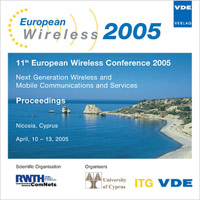Inter-Cell Scheduling in Wireless Data Networks
Conference: European Wireless 2005 - 11th European Wireless Conference 2005 - Next Generation wireless and Mobile Communications and Services
04/10/2006 - 04/13/2005 at Nicosia, Cyprus
Proceedings: European Wireless 2005
Pages: 7Language: englishTyp: PDF
Personal VDE Members are entitled to a 10% discount on this title
Authors:
Bonald, Thomas; Proutière, Alexandre (France Telecom R&D, 38-40 rue du Général Leclerc, 92794 Issy-les-Moulineaux, France)
Borst, Sem (Bell Laboratories, Lucent Technologies, P.O. Box 636, Murray Hill, NJ 07974-0636, USA)
Borst, Sem (CWI, P.O. Box 94079, 1090 GB Amsterdam, The Netherlands)
Abstract:
Over the past few years, the design and performance of channel-aware scheduling strategies have attracted huge interest. In the present paper we examine a different notion of scheduling, namely coordination of transmissions among base stations, which has received little attention so far. The inter-cell coordination comprises two key elements: (i) interference avoidance; and (ii) load balancing. The interference avoidance involves coordinating the activity phases of interfering base stations so as to increase transmission rates. The load balancing aims at diverting traffic from heavily-loaded cells to lightly-loaded cells. We consider a dynamic scenario where users come and go over time as governed by the arrival and completion of random data transfers, and evaluate the potential capacity gains from inter-cell coordination in terms of the maximum amount of traffic that can be supported for a given spatial traffic pattern. Numerical experiments demonstrate that inter-cell scheduling may provide significant capacity gains, the relative contribution from interference avoidance vs. load balancing depending on the configuration and the degree of load imbalance in the network.


